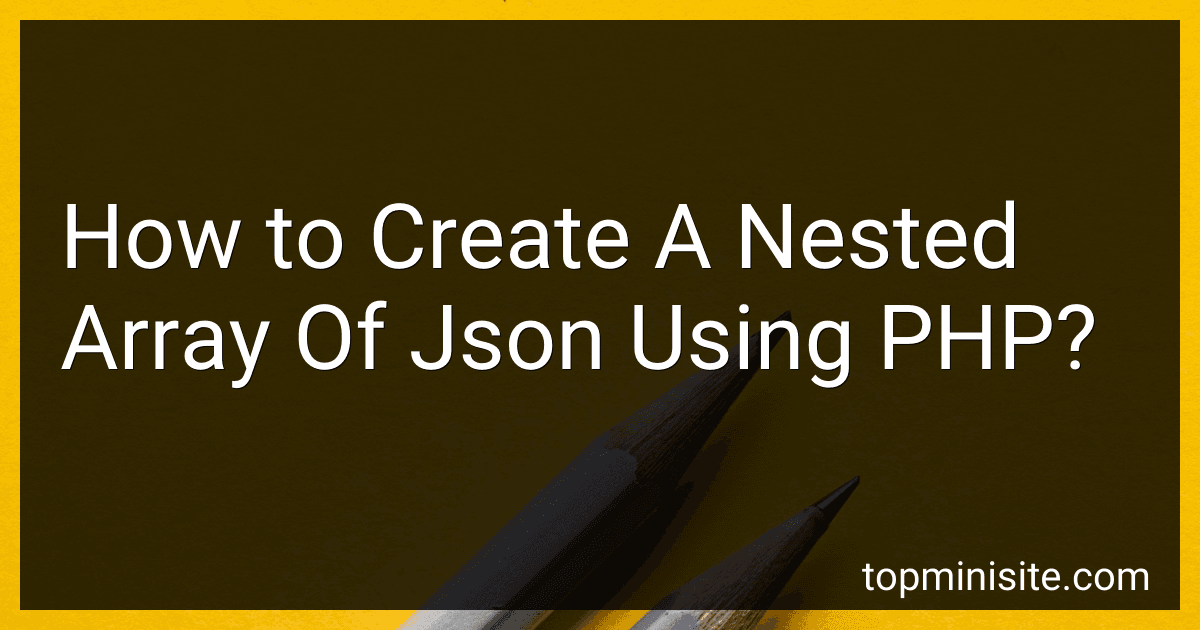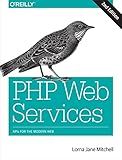Best PHP JSON Nesting Techniques to Buy in December 2025
To create a nested array of JSON using PHP, you can follow these steps:
- Start by creating an empty PHP array. This array will hold the nested data structure that will later be converted into JSON.
- Add key-value pairs to the array to form the nested structure. You can create sub-arrays within the main array by assigning an array to a specific key.
- Populate the sub-arrays with further key-value pairs to represent the desired structure.
- Once the array structure is complete, use the json_encode() function to convert the PHP array into a JSON string. This function automatically handles the conversion.
Here's an example of creating a nested array of JSON using PHP:
// Step 1: Create an empty PHP array $data = array();
// Step 2: Add key-value pairs to form the nested structure $data['name'] = 'John Doe'; $data['age'] = 30;
// Step 3: Create a sub-array within the main array $data['address'] = array();
// Step 4: Add key-value pairs to the sub-array $data['address']['street'] = '123 Main St'; $data['address']['city'] = 'New York'; $data['address']['country'] = 'USA';
// Step 3: Create another sub-array within the main array $data['contacts'] = array();
// Step 4: Add multiple key-value pairs to the contacts sub-array $data['contacts'][] = array('type' => 'email', 'value' => 'john@example.com'); $data['contacts'][] = array('type' => 'phone', 'value' => '555-1234');
// Step 5: Convert the PHP array to JSON $jsonData = json_encode($data);
After executing the above code, the $jsonData variable will hold a string containing the JSON representation of the nested array.
How to use the json_encode function to encode an array in PHP?
To use the json_encode function to encode an array in PHP, you can follow these steps:
- Create an array containing the data you want to encode.
- Use the json_encode function to encode the array into a JSON string.
- Optionally, you can specify additional parameters for more control over the output.
Here's an example:
$data = array( 'name' => 'John Doe', 'age' => 30, 'email' => 'johndoe@example.com' );
$jsonString = json_encode($data);
In this example, the array $data contains information about a person. The json_encode function is then used to convert the array into a JSON string and store it in the variable $jsonString.
You can also specify additional parameters to json_encode for more control over the output. For example, you can use JSON_PRETTY_PRINT to format the JSON string with indentation and line breaks for better readability:
$jsonString = json_encode($data, JSON_PRETTY_PRINT);
In this case, the JSON string will be formatted with proper indentation and line breaks.
Note: Make sure you have PHP version 5.2.0 or higher, as json_encode requires at least that version.
How to define a nested array in PHP?
In PHP, a nested array is simply an array that contains other arrays as its elements. Here's how you can define a nested array:
// Define a nested array $nestedArray = [ [1, 2, 3], ["a", "b", "c"], [true, false, true], ];
// Print the nested array print_r($nestedArray);
Output:
Array ( [0] => Array ( [0] => 1 [1] => 2 [2] => 3 )
\[1\] => Array
(
\[0\] => a
\[1\] => b
\[2\] => c
)
\[2\] => Array
(
\[0\] => 1
\[1\] =>
)
)
In the above example, $nestedArray is defined as an array that contains three arrays as its elements. Each nested array represents a row in a table.
How to handle nested arrays within a JSON string using PHP?
To handle nested arrays within a JSON string in PHP, you can use the json_decode() function with the second parameter set to true to convert the JSON string to a PHP associative array. Here's an example:
$jsonString = '{"name": "John", "age": 30, "nestedArray": {"key1": "value1", "key2": "value2"}}';
// Convert JSON string to PHP associative array $array = json_decode($jsonString, true);
// Access the nested array $nestedArrayValue = $array['nestedArray']['key1']; echo $nestedArrayValue; // Output: value1
In the above example, the json_decode() function is used to convert the JSON string to a PHP associative array. The second parameter, true, specifies that you want the result as an associative array.
You can then access the nested array values using the appropriate keys. In this case, the nested array is accessed using $array['nestedArray'], and the value for the key 'key1' can be accessed using $array['nestedArray']['key1'].
You can manipulate the nested arrays just like any other PHP array by accessing the desired keys and values within the nested arrays.
What is the use of the json_last_error function in PHP?
The json_last_error function in PHP is used to retrieve the last occurred error during a JSON operation. It returns an integer value representing the error code. This function is particularly useful in error handling when working with JSON data.
By calling json_last_error, you can determine the cause of an error after performing functions like json_encode or json_decode. The returned error code can then be used to identify the specific issue and take appropriate actions to handle it gracefully. This helps in troubleshooting and debugging JSON-related operations, ensuring proper error reporting and handling in PHP applications.
What is the difference between json_encode and json_decode functions in PHP?
The difference between the json_encode and json_decode functions in PHP is as follows:
- json_encode: This function is used to convert a PHP array or object into a JSON string. It takes the input data (array or object) and encodes it in JSON format, returning the resulting JSON string. This is useful when you want to send data from a PHP script to a client or another application that understands JSON.
Example:
$data = array("name" => "John", "age" => 30); $jsonString = json_encode($data); echo $jsonString; // Output: {"name":"John","age":30}
- json_decode: This function is used to convert a JSON string into a PHP array or object. It takes the JSON string as input and converts it into a PHP data structure, returning the resulting array or object. This is useful when you receive data in JSON format and need to manipulate it within your PHP script.
Example:
$jsonString = '{"name":"John","age":30}'; $data = json_decode($jsonString); echo $data->name; // Output: John
In summary, json_encode converts a PHP array or object into a JSON string, while json_decode converts a JSON string into a PHP array or object.
How to create a multi-dimensional JSON array using PHP?
To create a multi-dimensional JSON array using PHP, you can follow these steps:
- Create a PHP array with multiple dimensions, containing your desired data. For example:
$data = array( array( "name" => "John", "age" => 30, "city" => "New York" ), array( "name" => "Jane", "age" => 25, "city" => "Los Angeles" ), array( "name" => "Mike", "age" => 35, "city" => "Chicago" ) );
- Convert the PHP array into a JSON string using the json_encode() function:
$jsonData = json_encode($data);
- Optionally, you can format the JSON string for better readability by using the json_encode() function with the JSON_PRETTY_PRINT parameter:
$jsonData = json_encode($data, JSON_PRETTY_PRINT);
- You can then output or store the resulting JSON string as needed. For example, to output the JSON string, you can use echo:
echo $jsonData;
This will give you a multi-dimensional JSON array in the desired format.
What is the significance of json_decode when working with JSON in PHP?
The json_decode function in PHP is used to convert a JSON formatted string into a PHP variable. It is an essential function when working with JSON in PHP because it allows you to easily access and manipulate JSON data within your PHP code.
Some key significance of json_decode are:
- Data retrieval: It enables you to extract data from a JSON string and store it as a PHP variable, making it easier to work with and manipulate the JSON data in your PHP scripts.
- Object creation: JSON objects can be converted into PHP associative arrays or objects, allowing you to access and modify individual JSON properties like you would with regular PHP variables.
- Interoperability: JSON is a commonly used data interchange format, and being able to decode JSON in PHP enables seamless integration and communication with other applications or APIs that use JSON.
- Data validation: json_decode provides an optional second parameter to specify whether the resulting data should be returned as an associative array or an object. This allows you to validate and ensure the expected data structure when parsing the JSON string.
Overall, json_decode is crucial when working with JSON in PHP as it allows you to convert JSON data into a format that PHP can understand and work with effectively.



